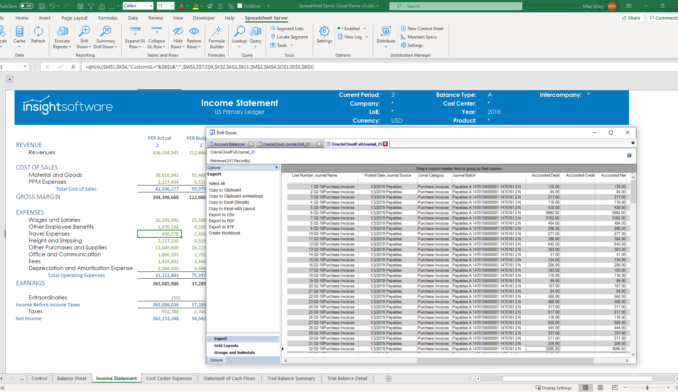Month-End Close Procedures Checklist

If you’re looking for a month-end close procedure checklist, you’ve come to the right place. In this article, we will discuss all the necessary procedures that your company needs to conduct before ending the month.
There are many ways in which your business can conduct a month-end close process–whether it be using financial reporting software, excel sheets, or an actual ledger book–but what’s important is that you cover all procedures effectively and precisely.
What is a Month-End Close Process?
For any serious organization, it’s crucial to be aware of the benefits that a month-end close process offers. Simply, month-end close processes are a complete and timely way to calculate accurate cash predictions for the coming months and assist business managers in assessing their financial performance. These accounting month-end close procedures track all the transactions made during the month and keep accounting data organized, which is why you should consider implementing one for your business.
When conducting a month-end close procedure, you’re essentially recapping all your progress during the month and setting your numbers in stone. By initiating month-end close procedures you’ll also be able to set more attainable goals for the future and accurately track business performance just in case you need it later.
What is Important When Conducting an Accounting Month-End Close Procedure?
Many businesses have failed due to not being able to recognize the importance of thinking about the most important elements and not storing away records accurately.
When conducting an accounting month-end close procedure, precision is key. This means that no transactions can be left out during the process to give the closest picture possible of how your company is doing so far. It’s also important to concentrate on the month-end profit and loss to analyze whether there is any discrepancy in the projected profit and actual profit rates, which could be attributed to external factors such as dishonest employees and accidents.
Although the details on what to cover when conducting a monthly close process will be covered later with a more comprehensive checklist, generally when conducting a month-end close process it’s crucial to make sure that all processing and transactions have been performed beforehand to limit error.
How can Financial Reporting Software Help with Month-End Close Procedures?
You might be a little confused on how financial reporting software helps with closing month-end books, and be hesitant to spend money on it. Wondering whether financial reporting software is a good fit for your office? Here are three ways in which business reporting software can greatly improve your efficiency for close procedures.
How to Compare Reporting & BI Solutions
Download NowTrend Identification
One of the main points of closing your books is seeing and understanding trends, something made easier with financial reporting software. With a thorough foundation of trends, you’ll be able to forecast growth for the coming months and see your progress and growth with less work involved.
Saves Time and Money
Frustrated with the sheer amount of time and money required for reports? Financial software acts as a “cheat code” for those who are interested in saving time and money on month-end close procedures. With a few taps of the keyboard, you’ll have everything you need to form a report that’s cohesive and just as informative as one put together manually.
Improved Debt Management
Hopefully, your company doesn’t have too much debt, but for those that do, financial reporting software will help reduce the stress that comes with the dreaded term by giving you a better picture of how exactly it’s being managed. It’ll show you all about your current assets and compare them to your current liabilities, so you have a clearer photo of your debt management.
With that being said, the wrong financial program chosen for your company does have the risk of doing more harm than good. Click here for more information on how to make wiser decisions for the benefit of your company.
5 Things Not to do When Choosing a Financial Reporting Tool
Download NowHow do you Conduct a Month-End Close Process?
If you have a moderately large business, initiating a month-end close process is a good idea. Conducting one will take some time, but it’s an important part of the accounting cycle.
Monthly close processes serve as a cutoff point for transactions, as they are essentially permanent income statement accounts. Income statement accounts are temporary and are only intended to store data for a certain amount of time. Once this data is transferred to a balance sheet using a month-end process the results can be viewed for a longer amount of time and portray the aggregate of financial activity at a single glance. Another thing that you might find beneficial is to create a month-end close checklist and actively tick off all the satisfied criteria, which we’ll get to later.
How Long will Closing the Books Take?
At the end of each month, there’s no denying that companies are under lots of pressure to get their books closed ASAP. Depending on the magnitude of the company and the number of people involved the time taken to close the books will vary, but generally, it’s a realistic goal to have them closed within seven days for most companies. It should be noted that sacrificing accuracy for speed isn’t necessarily the best way to end things, but taking too long might negatively affect your next month and productivity in the grand scheme of things. Without further ado, let’s get into the month-end close checklist.
Accounting Month-End Closing Checklist
Accounting can get tricky sometimes as the number of things you have to manage can seem overwhelming at first. To help break down all the tasks you need to complete, we’ve compiled an accounting month-end closing procedures checklist below! Remember to tick off all of these criteria (possibly on an Excel month-end close checklist) before closing your books, otherwise, you risk leaving out important information.
#1. Have You Recorded Incoming Cash?
You need to record the funds that you gained before closing your monthly books. Some types of income that you will need to keep track of include:
Loans: Have you lent any money to anyone? Has the money come back, and if so how much interest did you charge?
Invoice Payments: Ensure that you’ve sent invoices to all of your customers and that you have a record of all these invoices that you can use to close your books.
Revenue: Other types of revenue not covered by invoices also must be recorded in the month-end books. If your customer didn’t send you an invoice for some reason and paid using another method, include these incomes under a separate category and add them to the total later.
When recording incoming cash, you should need to keep up to date during the month, keeping track of all transactions made down to the dot. If your company uses credit and debit cards as a method of payment, import all of these into a spreadsheet. Check that all accounts payable bills have been recorded in the system–including recurring bills. Moreover, have you made sure all of your timesheets have been submitted and approved? To check, import, or post your payrolls.
#2. Have You Closed Sub-Ledgers?
Some transactions may still be pending or haven’t been approved. Others might still be in drafts or otherwise; if so, close them or resolve them for the next period and discount them from the accounting month-end closing checklist.
#3. Have You Reviewed Petty Cash?
This may not apply to all businesses, but for those utilizing petty cash/ petty cash funds as a method of payment you need to keep a record. The best way to do this is to keep track of all receipts for purchased items or items paid for using petty cash and keep this data safely stored ready for month-end close procedures.
If you haven’t reviewed the petty cash you’ve used, there’s a good chance that your month-end closures are incomplete and may skew the final results considerably depending on how much you rely on this method for transactions.
#4. Have You Looked at Fixed Assets?
Fixed assets are assets that are held in place for more than one year and are tangible pieces of equipment that a company might own and aren’t easily convertible to cash. More common terms for fixed assets include property, plant, and equipment.
There are many examples of fixed assets that you might have to take into consideration during your month-end close procedures, such as vehicles that are used for the company (company trucks, food trucks, etc.), buildings, and valuable office furniture.
These fixed assets that your company may own will depreciate as time goes by, so it’s useful to keep up to date with these depreciations to get a better idea of their current worth. Remember to record any payments that are related to your fixed assets, such as maintenance and renovations when closing your books. Run depreciation through the system and record journal entries.
To manage your fixed assets, make sure to generate the addition and review of a fixed asset invoice to check that your asset classification has been successful. If you’ve found errors, create manually fixed assets.
#5. Have You Considered Taxes?
All companies will have some extent of tax to consider, and though the percentage itself will depend on how much money your company is currently making it can also depend on other things. Tax can change according to property (think fixed assets), sales, and payroll amongst other factors.
#6. Have You Counted Your Inventory?
Counting your inventory monthly will improve accuracy and accurately record levels in your books, enabling you to eliminate problems associated with stock and demand. Inaccurate inventory tracking will ultimately lead to problems–including spoiled food if you’re running a restaurant or other outdated items that need to be replaced.
Doing monthly inventory counts will help you decide what items you need to fill up and how often, so start counting now!
#7. Have You Updated Your Accounts Payable?
Your accounts payable represents the money that you owe other people for goods and services that you have received. It is often broken up into different time buckets (30-day intervals) and referred to as accounts payables aging. This is directly related to the closing of your sub-ledger and general ledger/journal and requires reconciliation. The tracking of your accounts payable aging and month-end reconciliation is drastically easier when using financial reporting software.
#8. Have You Recorded Monthly Journal Entries?
Much like updating payable accounts, you also need to record monthly journal entries. These could include data from your payable accounts, financial statements, inventory tracking, and the like. A monthly journal entry won’t take up too much time given that you have access to all the required data and will be a useful set of data that you can regularly come back to if there are any complications.
#9. Have You Prepared Financial Statements?
Profit and Loss Statements
Profit and loss statements list all your sales and the experience that you have so far, informing you of all the progress you’ve made. These statements are so useful because you can use them to develop accurate sales targets and a reasonable price for your work.
Business Balance Sheets
Another type of financial statement is business balance sheets, which will assist your business in finding your assets and liabilities. You can work out your working capital, meaning the money you will need to spend every day, and your business liquidity, meaning the rate at which you can pay off your debts, effectively using business balance sheets.
General Ledger
Also known as a nominal ledger, general ledgers are bookkeeping ledgers that will keep data from journals and sub-ledgers. These general ledgers store a wide variety of information, including accounts payable, accounts receivable, cash management, fixed assets, and much more. Similar to a checkbook, credits are recorded on the right, and debits are recorded on the left side.
When it comes to financial statements, you should aim to organize them whenever possible–ideally weekly, so that by the time month-end procedures roll around you don’t have to look around for ones that have potentially gotten lost. Organize and review your financial statements so you don’t overspend or miscalculate other things later on.
You could also choose to record daily operational financial transactions, which will help you more to create timely and accurate financial statements.
#10. Have You Reviewed Your Information?
We’re all subject to human error, so it’s a good idea to review your information by a third party before submitting it. Managers, supervisors, or otherwise with accounting experience are the best people to go to for advice. If you don’t have anyone else above you that you can go for advice, another way to review your information is by checking articles (like this) to verify that you’ve finished all that needs to be done before the accounts are completely closed.
#11. Have You Started Preparing for Next Month?
Review the time it took for you to close your books this month, so you’re able to get an estimate of approximately when you should start closing your books next time. If you’ve found that you’ve made some errors or excluded a key part of the close procedures whilst reviewing the information you should keep note of this so that the same doesn’t happen next time around.
Closing Thoughts
Why Should You Close Your Books Monthly?
If you’re looking to expand your business or have ambitious goals, you should close your books monthly. Closing your books is essential as it shows you about your business’s financial information. The first couple of times that you close your books may be tricky, but the more you close your books the more you will get used to things and become more efficient. The earlier that you start, the better.
Other benefits of closing your books monthly include: making tax filing simpler, preparing you for the future, preventing future accounting month-end close procedure mistakes, and keeping a record for the future so you can view your progress in a nutshell.
Should You Have an Excel Month-End Checklist?
You should have an excel table to record all your transactions if you don’t have the software necessary. There are so many people that rely on an excel spreadsheet to view the information and make critical decisions, so when creating a month-end checklist with excel–precision is key. With that being said, there are other formats in which you can report your data–such as a KPI dashboard. To find out more about building useful KPI dashboards, click here.
We hope this article assisted you in finding out the basics of month-end close procedures and provided you with an appropriate month-end close checklist. Remember to review this checklist before you close your books for optimal performance and to make accounting a breeze, make the effort consistent and daily.








